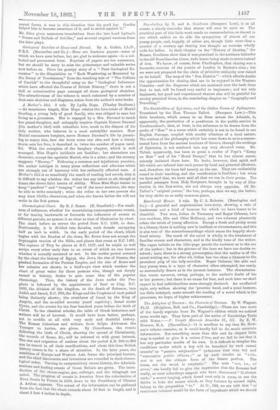Chronological Chart. By E. J. Eason (E. Stanford.)—For readi- ness
of reference, whether for ascertaining contemporaneous events, or for treeing backwards or forwards the influences of events at different periods, no system is so clear as that of illustration by chart. The chart before us covers the poriod from B.C. 1500, to date. Horizontally, it is divided into decades, each decade oocupying half an inch in width. In the early period of the chart, which begins with the Exodus of the Jews, Mr. Ensor does not accept the Septuagint version of the Bible, and places that event at B.C. 1491. The capture of Troy he places at B.C. 1127, and he might as well assign every other early date to an event of which no one knows whether it actually occurred or not. In the earlier period covered by the chart the history of Egypt, the Jews, the rise of Greece, the gradual formation of the Persian Empire, and the rise of Rome and her colonies are shown, in a bird's-eye view which renders the chart of great value for those persons who, though not deeply Versed in history, desire to gain some idea of the popular chronology. Thus, the history of the Jews under the Pro- phets is followed by the appointment of Saul as king, B.C. 1095, the division of the kingdom, at the death of Solomon, into .Judah and Israel, B.C. 976, the Kings and the Prophets of each period being distinctly shown ; the overthrow of Israel by the King of I-Billie., and the so-called seventy years' captivity ; Israel under Cyrus, and the events for the four hundred years before the birth of Christ, To the classical scholar, the table of Greek historians and "niters will be of interest. It would have been bettor, perhaps, not to meddle at all with very early and doubtful history. The Roman historians and writers, from Scipio Africanus the 'Younger to Arrian, are given. By Churchmen, the events following the birth of Christ, showing the spread of Christianity, the records of Rome, 8co., will be referred to with great interest. The rise and migration of nations about the period A.D. 200 to 600 can be traced in all their ramifications, and about this time British history comes in for a share of attention. In the later years, the Condition of Europe and Western Asia forms the principal feature, rd the chief discoveries and inventions are recorded in their (throne. giattl order. Turning to comparatively recent history, the Adminis- tdratic.eas and leading events of Great Britain are given. The intro- notion of the steara-engine, gas, railways, and the telegraph are no The progress of events in America from the colonisation of Nova Seethe by France in 1604, down to the Presidency of Chester A. Arthur, appears. The extent of the information can be gathered from the fact that the chart extends about 16 feet in length, and is about 2 feet 4 inches in depth.


































 Previous page
Previous page